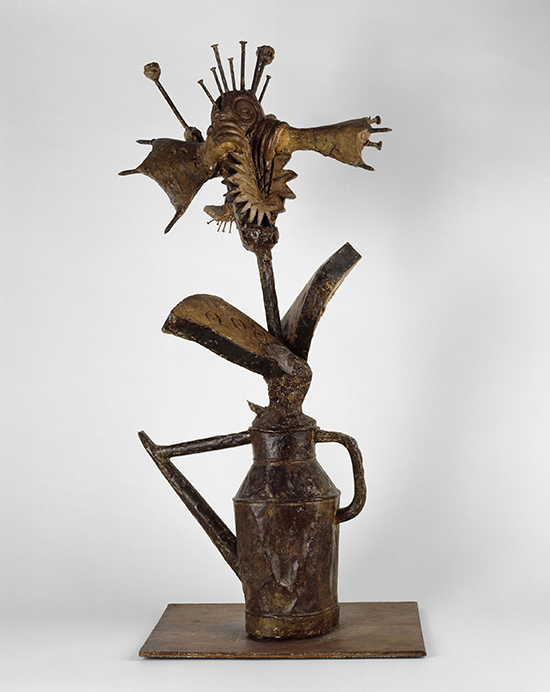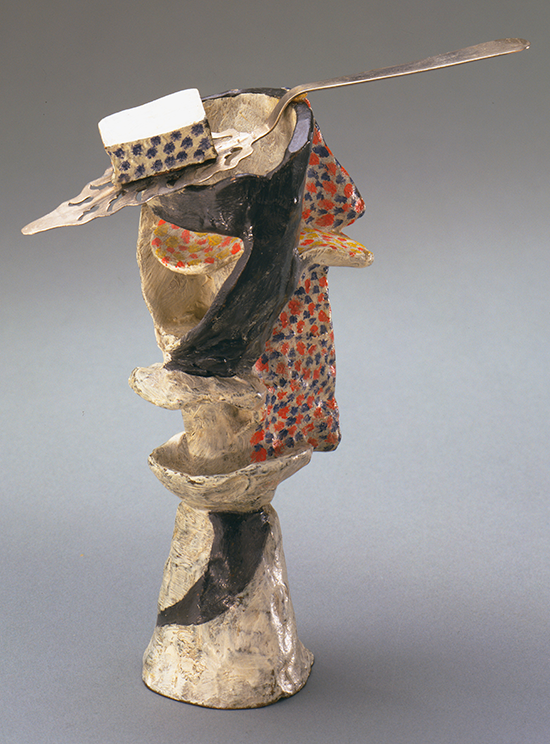The must-see museum show of the early fall has touched down at MoMA, and it is colossal. Any banner proclaiming PICASSO is bound to draw the masses, but this exhibition delivers its lines sotto voce rather than through the megaphones he gave to the Cubist stage manager in “Parade,” his masterpiece for the Ballets Russes.
The last time this many (140) examples of Picasso’s sculpture were on view in New York was 1967, a year after the Paris retrospective, “Hommage a Picasso,” when he finally allowed the sculpture to be seen in public.
.

"Guitar" by Pablo Picasso (Spanish, 1881–1973), Paris, 1924. Painted sheet metal, painted tin box, and iron wire, 43 11/16 × 25 × 10 1/2 inches. Musée national Picasso–Paris. © 2015 Estate of Pablo Picasso/Artists Rights Society (ARS), New York.
.
Ann Temkin is the chief curator of painting and sculpture at MoMA and head of the team responsible for this solid exhibition, which lavishes the entire fourth floor on the show so that the works can be seen in the round. Her team includes Anne Umland, also of MoMA and Virginie Perdrisot of the Musee Nationale Picasso-Paris, which loaned 50 works. The gravitas and integrity of this exhibition catapults Temkin into the ranks of her distinguished predecessors Alfred Barr, Thomas Hess, Kirk Varnedoe and most notably William Rubin.
.

"Flowery Watering Can" by Pablo Picasso (Spanish, 1881–1973), Paris, 1951-52. Plaster with watering can, metal parts, nails, and wood, 33 11/16 × 16 9/16 × 14 15/16 inches. Musée national Picasso–Paris. © 2015 Estate of Pablo Picasso/Artists Rights Society (ARS), New York.
.
The beginning is the best place to start this chronological survey of the phases of his sculpture, which do not align conveniently with the painting periods (and occasionally, as in the 1920s, Picasso backed off sculpture). Picasso was under the spell of Rodin and his pupil Bourdelle, Degas and especially Gauguin in the early works, especially The Jester (for which Max Jacob modeled) and the boldly angular Head of a Woman, a crucial work from 1909 that suggests not only Matisse but Wyndham Lewis and relates to the Demoiselles D’Avignon. The wooden carvings of the Ivory Coast and a prized Wobe mask he owned, its mouth a prism like the Cubist paintings, linger in the background of influences.
In a press briefing, Temkin explained that Picasso waited until 1966 to reveal his “private museum” of sculpture, a vital facet of his studio practice even if it was kept in the background. The reason for his reticence, she said, was because he was coy, in a way that suggests other painters who play with wax, bronze, wood, plaster, terra cotta and cardboard such as Edgar Degas and Cy Twombly.
There is a quiet intimacy about the exhibition that will disappoint those who leave New Jersey to see brash Blue Period paintings. Let them exit through the gift shop swiftly, because there is plenty of marvelous painting in the exhibition. Slip around to the back of Violin and Bottle on a Table, for example, and catch the Twombly painting blooming on the rough fir surface.
In the Cubist room as well, the six painted bronze casts of the glass of absinthe are gathered together, fantastic examples not just of the painterly touch (color and sculpture are usually so hard to get right) but the play of transparency and solidity when Picasso makes an object into sculpture. Peering into the glass, it is possible to see how solids become analytic moments of disclosure, simultaneously inner and outer. Picasso modeled them in wax, and the museum is proud to have reunited all six for the first time since they left the studio.
.

"Glass of Absinthe" by Pablo Picasso (Spanish, 1881–1973), Paris, spring 1914. Painted bronze with absinthe spoon, 8 1/2 x 6 1/2 x 3 3/8 inches, diameter at base 2 1/2 inches. The Museum of Modern Art, New York. Gift of Louise Reinhardt Smith. © 2015 Estate of Pablo Picasso / Artists Rights Society (ARS), New York.
.
The sheet metal pieces in a sunlit gallery are delicately brushed, three-dimensional portraits. Sylvette, for instance, is a virtuoso example of the grisaille he used in Guernica. If it seems familiar, you may have walked by the Sylvette 20-foot-tall concrete enlargement erected in 1968 at New York University.
While we are on the topic of enlargement, a little journalistic tidbit: When Apollinaire died in 1918, Picasso was the choice for the creation of his monument (he owed it to the poet, who went to jail in his place in a case involving illegal sculpture, but that is a story for another day). Picasso uncharacteristically struggled with the commission until he came up with the idea of “drawing in air” with iron wire (Julio Gonzalez was welding with him from 1930-1932).
The delicacy of the two examples from 1928 in a gallery dominated by the commission are breathtaking, but I had to wonder why the version I had often seen in the garden of MoMA was conspicuously absent. On background, a MoMA curatorial assistant, eyes downcast, muttered “enlargement.” Brava, Ann Temkin. Only the ones that Picasso laid hands on make the cut for the show.
In the Boisgeloup room, monumentality raises the volume level even as it threatens to introduce the type of rhetoric that was missing in the lyric poetry of the Apollinaire room. This is the only part of the show that includes drawings—meticulously shaded, contour renderings that cast the shadows to the left, welcome aids to finding the angles from which the sculpture works best.
There is a brief interlude of ceramics, which struck this viewer as the weakest part of the exhibition. It is curious, though, that some of them were cast as bronze. The heroic ending to the show includes two of the most famous works, the compelling Head of a Bull (1942), cast from a bicycle seat and handlebars found in the trash, which has a dramatic huge gray wall of its own, and Man with a Sheep, cast a year later. The maestro modeled it in a single day.
A portfolio of Brassaï’s photographs of the sculpture is hung in a separate gallery. Brassai first shot the work on assignment for Albert Skira’s magazine Minotaure in 1932, when he visited the Rue la Boétie studio and then a year later visited the Chateau de Boisgeloup where Picasso had turned the stables into a dream workshop for sculpture. The hefty Roman plasters and bronzes he created there include the bust of the centurion (his eyeball was initially a tennis ball). These neo-classical works respond as well to the visit he paid to the Farnese marbles with Jean Cocteau and Sergei Diaghilev when he first started working with the Ballets Russes.
Brassaï was convinced that Picasso’s sculptures were the key, in part, to decoding the pictures. He wrote in 1964, “In my opinion Picasso’s sculptures are somehow the foundation for his painting and often where his ideas are conceived and developed.” That is more than enough reason to pay strict attention in the Cubist gallery of the MoMA exhibition to the compositional and spatial ideas presented even by tiny wall reliefs made of bits of wood, angled from one another and the wall in the faceted manner of the Cubist paintings.
Brassaï had a trick, which he explained to the artist one day. “Some stupid tradition requires that a light-colored statue be stood up against a white background. It’s the death of them. They look flattened and can’t breathe in the space. For a sculpture to achieve its full round shape, its lit parts have to be brighter than the background and its dark parts darker. It’s so simple.”
____________________________
BASIC FACTS: “Picasso Sculpture,” September 14, 2015 to February 7, 2016, at the Museum of Modern Art, 11 West 53rd Street, New York, NY 10019. www.moma.org
____________________________
Copyright 2015 Hamptons Art Hub LLC. All rights reserved.
